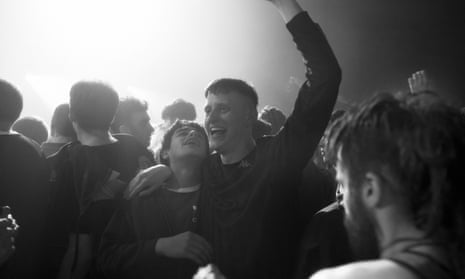Beats is a gem of a film that has drawn attention not just for its exuberant depiction of early 1990s rave culture but the deeper questions it raises, 25 years on, about the legislation that criminalised the free party movement – and about how the UK pivoted from Reclaim the Streets, via Cool Britannia, to Brexit Britain.
Set in the summer of 1994, as the Criminal Justice Bill threatened to outlaw musical gatherings around “sounds wholly or predominantly characterised by the emission of a succession of repetitive beats”, the film charts the friendship – by turns madcap and tender – between teenagers Johnno and Spanner as they struggle to escape the restrictions of family and class on their West Lothian housing estate. With the help of a sisterly gang of older girls, the boys bounce into their local rave scene and soak up the ethic that “the only good system is a sound system, and if I can’t dance then it’s not my revolution”.
“I’ve always been interested in the politics of mass gatherings of young people,” explains Kieran Hurley, who adapted the screenplay for Beats from his acclaimed Edinburgh Fringe play with director Brian Welsh. Noting that the film’s political setting is the genesis of New Labour, he adds: “We were trying to set this mad communal euphoria against the context of a world that is encouraging people to behave in a certain individualistic and aspirational way, to underline how rave was a cultural reaction against some of that.” It’s worth recalling that, while the 1994 act marked one of the final legislative excesses of the Conservative government, the subsequent New Labour regime hardly covered itself in glory over civil liberties.
Hurley sees significant resonances between the protests around the 1994 bill and the Extinction Rebellion activists of today. “There’s something about the aesthetic of celebratory protest, claiming space and shutting it down, that you can draw directly back to Reclaim the Streets and the party protest moment, and that all comes out of the Kill the Bill protests. There’s a direct lineage.”
Beats serves as a timely reminder of that initial injection of creativity – and music – into mass protest, and demands a hat-tip of recognition to those who were shouting about the environment, the erosion of public space and the dangers of cheap credit long before these concerns entered the mainstream.
It is also one of the few films to authentically capture the dancefloor experience. With a soundtrack curated by Glasgow clubland legend JD Twitch, the final, extended rave scene switches between moments of hands-in-the-air euphoria and bursting full-colour visuals from Weirdcore, music video director for Aphex Twin and Radiohead. It is a “Wizard of Oz moment”, as Welsh puts it.
If the rave looks genuine, says Welsh, that’s because it was. “I was very clear that to make this work we had to have a proper rave with real people and real music in a secret location. We had to deconstruct the traditional way of shooting a party scene, where the music plays for a couple of minutes, someone calls cut and everyone keeps fake dancing while we record the dialogue. A lot of the sound is synced sound so you’ve got the atmosphere of the crowd and screams at the appropriate points in the music, and all that makes it a more authentic experience.”
But Beats also offers a defiant riposte to the numbing capacity of cynicism, advocating instead for experience: because everything is new to somebody. “It’s a fag-end scene, it’s been done,” moans Spanner as the boys arrive at the final rave of the summer. Johnno’s reply is as galvanising as it is universal: “It’s not been done by us.”
